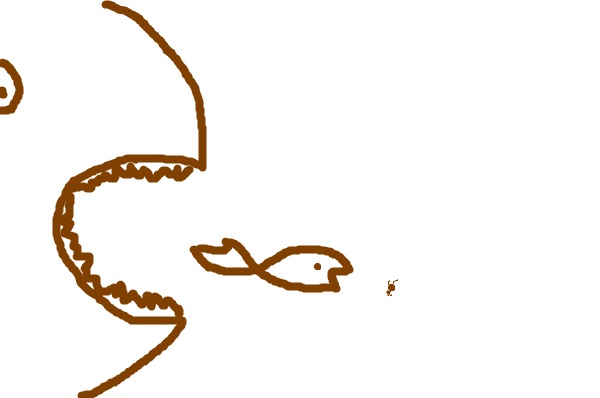A yellow perch in murky water
Big fish, little fish, hump-shaped foraging curves, and the landscape of fear.
by Liza Lester, ESA communications officer
IN LIFE, much depends on context. The benefits accruing from the pursuit of liberty, lunch, and other forms of happiness, are tempered by the presence of risk. This is as true for small fishes as for anyone.
In Lake Erie, young yellow perch (Perca flavescens) forage for the grab-bag category of microscopic, drifting crustaceans and jellyfish known as zooplankton, while dodging the predatory menace of larger, fish-eating fish (and in these northern, temperate waters, adult yellow perch are among the deadly threats to be avoided! In aquarium tests, a single adult yellow perch could eat 100 newly hatched yellow perchlings in less than 2 minutes. More on this later.).
Big fish – top predators in this situation – indirectly influence the abundance of zooplankton by eating down the numbers of “planktivores.” Young perchlings that escape consumption are further slowed in their own foraging by the necessity of avoiding death – and thus the zooplankton are twice spared. This tiered arrangement of consumption and influence is well known to aquatic ecologists, and repeats itself with other fishes, in ponds and lakes the world over.
The big fish – little fish – zooplankton relationship is buffered by the presence of murky sediments suspended in, and therefore obscuring, the watery world. Murk limits the senses of the fish. Both big and little fish hunt primarily by sight, but big fish hunting smaller fish prey are more quickly hampered by the obscuring murk than little fish looking for zooplankton.
In a mid-December paper for Ecosphere, Kevin Pangle and colleagues argue that zooplankton-eating little fish take advantage of the murky water, changing their behavior. Freed (to varying degrees) from the fear of becoming a meal for a bigger fish, the yellow perchlings pursue zooplankton with a more aggressive focus. The little fish know that the big fish are still around, out there in the murk; they can smell the danger that they can’t see. (Remember the 2-minute aquarium massacre? After 24 hrs, water from the tank in which this carnage occurred still contains chemical evidence detectable by other yellow perchlings – the smell of deadly menace, presumably, also known as a “predator cue.” The hatchery-bred perchlings have not encountered predators before; their avoidance behavior comes pre-programed.)

Hump-shaped: zooplankton in the gut of yellow perch hatchlings as a function of lake depth (inversely proportional to murkiness). From Figure 2 of Pangle et al. (A) yellow perch in Lake Erie, (B) white and black crappie in Ohio reservoirs, and (C) bluegill in Alabama ponds.
Past a certain point of murkiness, the inconvenience of the gloom begins to overwhelm its benefit for the little fish, the middle link in the chain of consumption. The little fish have trouble seeing their own zooplankton prey, and their foraging success (as measured by stomach contents) drops back down. This combination of factors predicts a “hump-shaped” curve of murkiness to zooplankton consumption (“hump-shaped” turns out to be charmingly explicit ecological dialect for “unimodal”). In the absence of big fish predators (or a bad smell of predators), increasing murkiness only obscures the zooplankton, predicting a flat, declining trend of zooplankton consumption as murk density grows.
The authors tested their prediction in lab experiments and wild observations. The predictions held up for yellow perch in the lab aquaria and Lake Erie, and for bluegill sunfish in Alabama ponds and black and white crappie in Ohio reservoirs – ecosystems of different size, character, and food-web composition. This information will be useful, the authors say, for other modelers, who usually assume murkiness only impedes the foraging progress of the planktivores, and perhaps for understanding the fickle, fretful survival of fish hatchlings in the wild.
![]() Pangle, K., Malinich, T., Bunnell, D., DeVries, D., & Ludsin, S. (2012). Context-dependent planktivory: interacting effects of turbidity and predation risk on adaptive foraging Ecosphere, 3 (12) DOI: 10.1890/ES12-00224.1
Pangle, K., Malinich, T., Bunnell, D., DeVries, D., & Ludsin, S. (2012). Context-dependent planktivory: interacting effects of turbidity and predation risk on adaptive foraging Ecosphere, 3 (12) DOI: 10.1890/ES12-00224.1
